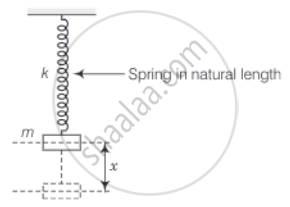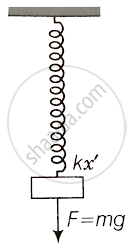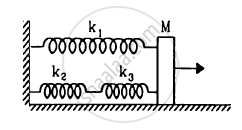Advertisements
Advertisements
Question
A body of mass m is attached to one end of a massless spring which is suspended vertically from a fixed point. The mass is held in hand so that the spring is neither stretched nor compressed. Suddenly the support of the hand is removed. The lowest position attained by the mass during oscillation is 4 cm below the point, where it was held in hand.
What is the amplitude of oscillation?
Solution
When the support of the hand is removed, the body oscillates about a mean position.

Suppose x is the maximum extension in the spring when it reaches the lowest point in oscillation.
Loss in PE of the block = `mgx` ......(i)
Where m = mass of the block
The gain in elastic potential energy of the spring = `1/2 kx^2` ......(ii)
As the two are equal, conserving mechanical energy,
We get, `mgx = 1/2kx^2` or `x = (2mg)/k` ......(iii)
Now, the mean position of oscillation will be, when the block is balanced by the spring.

If x' is the extension in that case, then F = + kx'
But `F = mg`
⇒ `mg = + kx^'`
or `x^' = (mg)/k` ......(iv)
Dividing equation (iii) by equation (iv),
`x/x^' = ((2mg)/k)/((mg)/k)` = 2
⇒ `x = 2x^'`
But given x = 4 cm ......(maximum extension from the unstretched position)
∴ `2x^'` = 4
∴ `x^' = 4/2` = 2 cm
But the displacement of mass from the mean position to the position when the spring attains its natural length is equal to the amplitude of the oscillation.
∴ A = x' = 2 cm
Where A = amplitude of the motion.
APPEARS IN
RELATED QUESTIONS
The maximum speed and acceleration of a particle executing simple harmonic motion are 10 cm/s and 50 cm/s2. Find the position(s) of the particle when the speed is 8 cm/s.
The equation of motion of a particle started at t = 0 is given by x = 5 sin (20t + π/3), where x is in centimetre and t in second. When does the particle
(a) first come to rest
(b) first have zero acceleration
(c) first have maximum speed?
The pendulum of a clock is replaced by a spring-mass system with the spring having spring constant 0.1 N/m. What mass should be attached to the spring?
A block suspended from a vertical spring is in equilibrium. Show that the extension of the spring equals the length of an equivalent simple pendulum, i.e., a pendulum having frequency same as that of the block.
The springs shown in the figure are all unstretched in the beginning when a man starts pulling the block. The man exerts a constant force F on the block. Find the amplitude and the frequency of the motion of the block.

Find the elastic potential energy stored in each spring shown in figure, when the block is in equilibrium. Also find the time period of vertical oscillation of the block.
A rectangle plate of sides a and b is suspended from a ceiling by two parallel string of length L each in Figure . The separation between the string is d. The plate is displaced slightly in its plane keeping the strings tight. Show that it will execute simple harmonic motion. Find the time period.

A body is executing simple harmonic motion with frequency ‘n’, the frequency of its potential energy is ______.
Draw a graph to show the variation of P.E., K.E. and total energy of a simple harmonic oscillator with displacement.
A particle undergoing simple harmonic motion has time dependent displacement given by x(t) = A sin`(pit)/90`. The ratio of kinetic to the potential energy of this particle at t = 210s will be ______.
